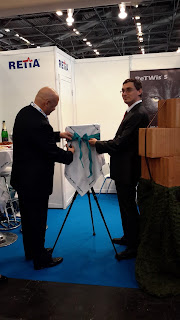RETIA presented a new variant of its ReTWis security radar to potential customers at MILIPOL 2015.
The new radar - named ReTWis 5 - is a portable system that, "will be available during the second half of 2016," according to Radim Sikl, the firm's Chief of Sales & Marketing, Localisation Systems.
He told MT that the new imaging radar, which is designed to detect living objects concealed behind walls and other non-metallic obstacles, will be marketed primarily throughout Europe and in Asia, with the latter representing much more potential, "for larger quantities," of devices. In a number of European countries, where the system's predecessor (ReTWis 4.3) is performing well, however, budgetary constraints could have, "an impact," on the number of systems ordered, according to Sikl. The ReTWis 4.3 attracted considerable interest by police and military forces, as well as rescue units, he added.
Information gained from the new radar on display at MILIPOL 2015 can be displayed in real-time using either 2D or 3D. The technique found in the radar is primarily based upon Step Frequency Continuous Wave (SFCW) technology, and an adaptive capability for improving sensitivity and overwhelming of jamming.
The new radar - named ReTWis 5 - is a portable system that, "will be available during the second half of 2016," according to Radim Sikl, the firm's Chief of Sales & Marketing, Localisation Systems.
He told MT that the new imaging radar, which is designed to detect living objects concealed behind walls and other non-metallic obstacles, will be marketed primarily throughout Europe and in Asia, with the latter representing much more potential, "for larger quantities," of devices. In a number of European countries, where the system's predecessor (ReTWis 4.3) is performing well, however, budgetary constraints could have, "an impact," on the number of systems ordered, according to Sikl. The ReTWis 4.3 attracted considerable interest by police and military forces, as well as rescue units, he added.
Information gained from the new radar on display at MILIPOL 2015 can be displayed in real-time using either 2D or 3D. The technique found in the radar is primarily based upon Step Frequency Continuous Wave (SFCW) technology, and an adaptive capability for improving sensitivity and overwhelming of jamming.
Stefan Nitschke




No comments:
Post a Comment